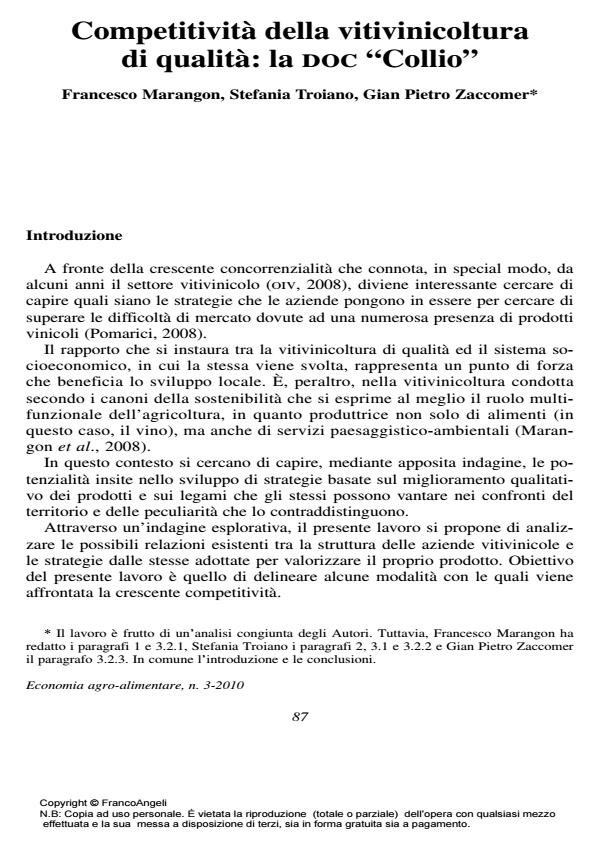Competitiveness of quality wines production: the case study of DOC "Collio"
Journal title ECONOMIA AGRO-ALIMENTARE
Author/s Francesco Marangon, Stefania Troiano, Gian Pietro Zaccomer
Publishing Year 2011 Issue 2010/3
Language Italian Pages 18 P. 87-104 File size 361 KB
DOI 10.3280/ECAG2010-003005
DOI is like a bar code for intellectual property: to have more infomation
click here
Below, you can see the article first page
If you want to buy this article in PDF format, you can do it, following the instructions to buy download credits

FrancoAngeli is member of Publishers International Linking Association, Inc (PILA), a not-for-profit association which run the CrossRef service enabling links to and from online scholarly content.
The international market of wine has been characterized by growing competition, expecially in recent years. Wine is one of the main agroalimentary products for Italian export. From wine export depends Italian balance of trade. In this context, the study aims to identify the role of quality wine, which is strongly linked to the geographical location. In fact, this relation seems to be a strong tool in favour of international competition. To this purpose we will describe the multifunctional role of wine growing in a specific area, the Collio, in Italy. Then we will analyse the chosen data set. The data were collected by quality wine producers that are partner of a Consortium. The Consortium safeguards and attests the quality of wine production. Finally, in order to study the data we used descriptive statistics and the twostep cluster analysis technique of spss®. The use of twostep analysis represented a first exploratory application of appropriate statistical techniques to study the relationship among some variables. This technique alongside models of wine producers behaviour permits the analyst to explore wine production segmentation by describing different types of wine producers strategies. Each group was characterised by common behavioural features, which we have outlined below. By observing the clusters of wine producers, we noted that: i) group "1": it was the largest; it was characterized by wine producers which used little or enough promotion, that encouraged the regional Consortium creation and had low regional market for their products (max 25%); ii) group "2": it was characterized by little or enough promotion; some of the wine producers of this group supported the regional Consortium creation, while others were not likely to encouraged it; it was characterized by middle-high regional market quota (more than 25%); iii) group "3": it was the smallest; its wine producers used a lot promotion; there was not a homogeneous support in favour of regional Consortium creation; regional market quota was low (max 25%); iv) group "4": it was similar to group "1", but there was an important difference as regards regional Consortium, in fact, it did not encouraged its creation; it had low regional market quota (max 25%). The information we collected was sufficient to construct a market segmentation model. This type of examination seems to be very useful to wine producers. In fact, it give them the opportunity to understand the strategies of their competitors. Undoubtedly, the data collected allowed us to analyse the role of local territory and the importance of local identity to typical products. Such analysis has become increasingly important for the wine sector, in which there is a specific institution - the Consortium - that has the duty to guarantee and promote mark guaranteeing quality. The Consortium gives wine producers the opportunity to increase the knowledge of consumers about the wine quality. From the data collected we observed the importance of Consortium to wine producers. At the same time, it is generally acknowledged that it is fundamental for wineries to promote local territory to increase the value of its products. Nevertheless, only bigger wine producers hope for the development of territorial brand and the cooperation among several stakeholders.
Keywords: Quality wines, competitiveness, multifunctionality, market segmentation model
Jel codes: Q13, C19
- Standard output versus standard gross margin, a new paradigm in the EU farm economic typology: what are the implications for wine-grape growers? Giuseppe Di Vita, Gaetano Chinnici, Gioacchino Pappalardo, Mario D'Amico, Salvatore Bracco, in Journal of Wine Research /2014 pp.229
DOI: 10.1080/09571264.2014.959660
Francesco Marangon, Stefania Troiano, Gian Pietro Zaccomer, Competitività della vitivinicoltura di qualità: la doc "Collio" in "ECONOMIA AGRO-ALIMENTARE" 3/2010, pp 87-104, DOI: 10.3280/ECAG2010-003005